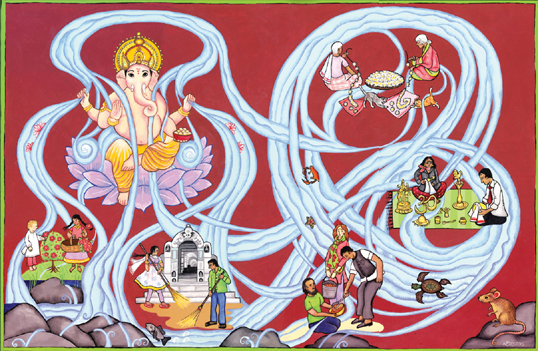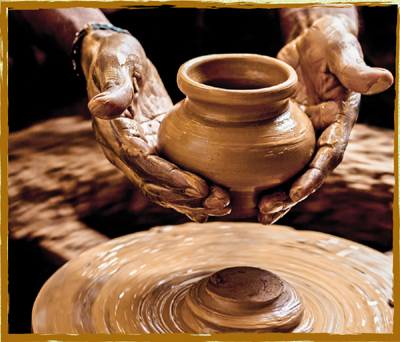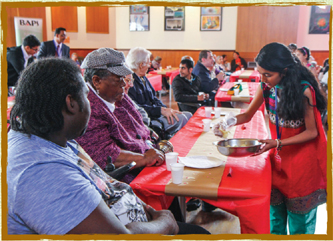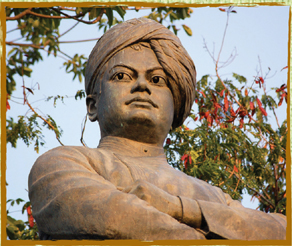How Simple Actions Become Divine Expressions
TAKEN IN ITS HIGHEST AND TRADITIONAL sense, karma yoga is the constant effort to surrender to God’s will, to see Her/Him in everything and everyone and to perform every action as a divine offering, in a spirit of love and detachment.
In his translation of the Bhagavad Gita, Christopher Isherwood commented on acting without attachment: “In general, mankind always acts with attachment; that is to say with fear and desire. Desire for a certain result and the fear that this result will not be obtained.…The doer of non-attached action, on the other hand, is the most conscientious of men. He does not run away from life; he accepts it much more completely than those whose pleasures are tinged with anxiety and whose defeats are embittered by regret. No matter whether he is sweeping a room or calculating the position of a star, or taking the chair of a meeting, he does it to the utmost limit of his powers—so carefully, so devotedly, so wholeheartedly, that the dividing line between the chosen activity and the necessary chore disappears. All work becomes equal and vitally important. It is only towards the results of the works that he remains indifferent.”
Satguru Yogaswami advised devotees, “Whatever work you have to do, do it well. That in itself is yoga.”
Swami Chinmayananda taught in his book We Must: Twenty-Two Notes on Self Perfection, “Let our work speak for itself. No covering it with an excuse. Excuses are just the expressions of our weakness in the field of action. Reveling in our tiredness; joyous in our exhaustion, blissful with our fatigue, we shall still work on inspiredly in our endless love for Him who is thrilling us into performance from within.…While thus working, we must cultivate in ourselves a special brand of independence—a spirit which shall sustain us, both in the busy marketplace and in the meditation seat. In the midst of the contending crowd or in the peaceful solitude, this daring spirit of freedom and fearlessness alone should spring forth from our consciousness that we are upright and pure, diligent and clean, both in our thoughts and actions.”

DINODIA
In the workplace: A craftsman restores a chair seat in Italy
My Gurudeva explained: “The [Tamil] word Sivathondan signifies a ‘devoted servant of God’ or ‘one whose service is devoted to God’—that is, one who does everything that he has to do for God, and not for himself. He must do his duty as a good servant. The results, whether successful or unsuccessful, are the concern of his master. As his actions are performed for God, he must execute them as well as he possibly can. Every act, from the grandest and noblest to the meanest and most trivial, thus becomes a sacred rite and then ‘work is worship.’ In this way the whole of life is sanctified and the distinction between ‘material’ and ‘spiritual’ ceases to exist.” The attitude of surrendering all actions as service to the Lord is called Ishwara arpana buddhi in Sanskrit.

BAPS SWAMINARAYAN SANSTHA
An artisan paints the eyes of the Goddess in preparation for a Durga festival
Sri Aurobindo wrote, “All work done for the Divine, from poetry and music to carpentry or baking or sweeping a room, should be made perfect even in its smallest external detail, as well as in the spirit in which it is done, for only then is it an altogether fit offering.”
Two Scriptural Sources
By Pandit Vamadeva Shastri (David Frawley)
Bhagavad Gita
THE BEST KNOWN SCRIPTURAL BASIS FOR THE YOGA OF ACTION IS the Bhagavad Gita. Within its pages we learn that karma yoga means pursuing the highest excellence and acting with the highest integrity for the Divine, guru and the good of all. This is the true meaning of its proclamation, “Yoga karmasu kaushalam” (“Yoga is skill in action”). Karma yoga does not mean simply acting without regard to consequences but rather seeking the highest good possible for everyone. It requires not seeking the fruits of action for oneself, on one hand, and making the action successful for the sake of dharma, on the other. Action done poorly or carelessly, or which fails to achieve its goal cannot be regarded as karma yoga.
Here are three key verses from Chapter Three, “The Yoga of Action,” instructions from Krishna to the warrior prince Arjuna translated and commented on by Swami Nikhilananda (1895–1973).
Verse 9: “The world becomes bound by action unless it be done for the sake of sacrifice. Therefore, O son of Kunti, give up attachment and do your work for the sake of the Lord.” Commentary: “Work that is done with a view to pleasing the Lord and not from any personal motive does not bind the worker.”
Verse 19: “Therefore always do without attachment the work you have to do; for a man who does his work without attachment attains the Supreme.” Commentary: “A seeker who does his duty for the gratification of God attains purity of mind and ultimately realizes the highest goal. Wise men in the past acted in that manner.”
Verse 25: “As the ignorant act, attached to their work, O Bharata, so should an enlightened man act, but without attachment, in order that he may set people on the right path.” Commentary: “An ignorant person acts zealously for his personal happiness; but a wise man should act, with the same zeal, for the welfare of others. The only incentive to action for a knower of the Self is the welfare of others.”

S RAJAM
Venerable teachings: Shri Krishna advises Prince Arjuna on the nature of karma
Karma yoga requires giving up the ego and attachment to material rewards. Yet, once we align ourselves with the Divine will, our power of action will increase manifoldly. The kriya shakti, or power of action, of the yogi is much stronger than that of ordinary people, who are limited by fear and desire. Detachment in turn improves our ability to act creatively and decisively. Those who are bound by desire act according to desire, which distorts their ability to see the nature of forces operative in the world and causes them to disturb the natural equilibrium. The wise, who are detached in their vision, see things as they are and act effectively for the best that is possible.
Karma yoga is also not limited to seva or selfless service, as it is usually interpreted in the West. In Vedic thought, it includes puja and yajna, or ritual. All action done as karma yoga becomes a ritual or worship of the Divine. Even seva should be done as a ritual, accompanied by mantra, meditation and remembrance of the Divine. Temple worship is a kind of karma yoga. Karma yoga requires bhakti or devotion. We must surrender to the Divine and to the guru for our action to carry the yoga shakti. Karma yoga ultimately means that our life itself must become a divine work, not merely a personal expression. As such, karma yoga is the basis of all other yoga paths.
Isha Upanishad
It is highly significant that the Isha, the shortest (having just 18 verses) and by most accounts the oldest of the Upanishads, extols karma yoga in its first two verses.
Verse 1: “The entire universe is pervaded by the Lord—whatsoever there is in this changing world. By this attitude of renunciation experience your life. Do not desire the wealth that anyone has.”
Commentary: If we recognize the atman as the indwelling Self and spirit, pervading the entire universe, present in each thing within the universe, we naturally develop a sense of renunciation and detachment. We will not seek what anyone has, because we realize that no one really owns anything. Everything belongs to and is rooted in the Divine. We need to surrender to that Divine will which is the energy behind all.
Verse 2: “Thus (in that spirit of renunciation) performing your work, may you wish to live a hundred years. Only in this way will karma not cling to your soul.”
Commentary: This recognition of the divine Self behind the entire universe is the foundation for karma yoga, action done with the attitude of renunciation—not merely renouncing the fruit of action but giving up the sense of being the owner and doer as well. Ishvara is the only doer, and His shakti is the only real power. Only if our lives are a form of karma yoga, rooted in an awareness of the divine presence, will karma not cling to and bind our souls.
To approach the wisdom of the Upanishads and jnana yoga, the understanding of our true nature, we must first develop the attitude of karma yoga—that we are not the doer. Karma yoga is rooted in devotion but also requires wisdom or jnana. We must be aware of the nature of the doer and the nature of the action. Karma yoga is action done with consciousness and creativity in accordance with the divine will.

SHUTTERSTOCK
Earth embraced by selfless, caring people
Nine Keys For Karma Yoga
PRACTICING KARMA YOGA CAN SOUND COMPLICATED, abstract and difficult. Here are nine keys to help bring it down to earth, ideals for practicing the yoga of doing—whether in a formal seva program, helping out at the temple, performing daily household chores or tackling tasks at your place of work. Is it practical to impose such a system without hindering one’s concentration on the task at hand? Yes. It is actually normal for our awareness to shift between five, six or more areas of concern through the day, like a bee flitting from one flower to another. Look at this set of keys as a new mental overlay of conceptual points for awareness to touch upon as you work, enjoy a meal, attend a class, or put on your shoes. No matter how well you fulfill them, they will be of benefit. Karma yoga can become a vital part of your daily life, making everything you do more selfless, effective and enjoyable.
 Offer all work to God. A mantra may be chanted, verbally or mentally, before beginning.
Offer all work to God. A mantra may be chanted, verbally or mentally, before beginning.
 Let Ganesha guide your karma yoga. He rules over all karmas, their fruition and their transcendence.
Let Ganesha guide your karma yoga. He rules over all karmas, their fruition and their transcendence.
 Act selflessly, detached from the results. Focus on serving, helping, giving and surrendering egotistical urges.
Act selflessly, detached from the results. Focus on serving, helping, giving and surrendering egotistical urges.
 Do your best. Make the work a worthy offering, completing it as perfectly as you can. Then stop, review what you did, and make it even better.
Do your best. Make the work a worthy offering, completing it as perfectly as you can. Then stop, review what you did, and make it even better.
 Be industrious. Stretch your capacities to overcome lethargy, fatigue, confusion and doubt. Remember to breathe.
Be industrious. Stretch your capacities to overcome lethargy, fatigue, confusion and doubt. Remember to breathe.
 Stay above the fray. Refrain from disagreements, criticism of others, cynicism, blame and other base emotions.
Stay above the fray. Refrain from disagreements, criticism of others, cynicism, blame and other base emotions.
 Stay focused. Be centered in the now, not thinking of other concerns. Pause between tasks and renew your yoga.
Stay focused. Be centered in the now, not thinking of other concerns. Pause between tasks and renew your yoga.
 Align your will with the divine will. Be rooted in an awareness of the divine presence within and around you. See the world as perfect.
Align your will with the divine will. Be rooted in an awareness of the divine presence within and around you. See the world as perfect.
 Enjoy the effort. Be positive, free of worry. Relax; take your time. Be happy and radiate blessings to the world.
Enjoy the effort. Be positive, free of worry. Relax; take your time. Be happy and radiate blessings to the world.

SHUTTERSTOCK
Helping hands: Comforting the aged and infirm
Working with Our Karma through Seva
THE FACT IS, THE MORE SELFISH WE ARE, THE LESS HAPPY WE ARE. And the less selfish we are, the happier we are. My Gurudeva, Satguru Sivaya Subramuniyaswami, advised: “Through service and kindness, you can unwind the subconscious mind and gain a clear understanding of all laws of life. Your soul will shine forth. You will be that peace. You will radiate that inner happiness and be truly secure, simply by practicing being kind in thought, word and deed.”
Every action we perform creates a samskara, a subtle impression in the mind. Each of us is the sum total of countless samskaras which makes up our unique individuality, determining our character and temperament and influencing our tendencies. The impressions left by previous actions become seeds or tendencies (vasanas) toward future effects. This is how we carry forward our karma. If our actions have been inharmonious, selfish or even cruel, then we will create situations in our future in which we absorb the effects or reactions of those actions. Samskaras of this quality bind us to the world in a way that makes life seem a bitter place. Spiritual or refined lifestyles are not possible when one is going through the turmoil of difficult past karma.
What is the remedy? Karma yoga. When we perform positive, unselfish, uplifting actions, we start accumulating positive samskaras. These mingle with our other less meritorious samskaras and begin to reshape our nature and future. Difficult karmic effects that we would have fully faced in the future become softened by the positive impressions of our present actions. If we act selflessly, offering the fruits our actions to the Divine, the creation of troublesome new samskaras is lessened and our overall karmic burden is gradually diminished.
Slowly the world becomes a more cheery place. But the world did not change. We have begun creating a positive and joyful nature simply through our own actions, a nature that is calm and balanced. In this newfound peace, we see the world in a positive light. Turning within, we become sensitive to subtle depths of our existence, not previously experienced.
Gurudeva explained it in terms of “actinic,” or spiritual energy. “The best way to keep the actinic force flowing through the physical body is practicing the art of giving, doing little things for others that you have not been asked to do. This keeps you creative; and being creative is actinic, superconscious and religious. Giving, doing without thought of return, affectionate detachment, creates an odic vacuum which your actinic, spiritual forces flow into and fill.”

SHUTTERSTOCK
A craftswoman in Kolkata decorates clay pots during the annual State Handicrafts Expo 2014
This is a gradual transformation, as Swami Vivekananda noted, “We have to begin from the beginning to take up the works as they come to us and slowly make ourselves more unselfish every day. At first our motives are selfish, but gradually this selfishness will melt by persistence until we are able to do really unselfish work.”
Narasimhachar Prativadi of Columbia, Missouri, offered, “Doing seva allows us for a short period of time to forget about our selfish thoughts and worries and focus on helping others. It is in a sense, another form of meditation. ‘Manava seva, Janardhana seva,’ ‘Service to man is service to God.’”
Testimonials on Replacing Pride with Humility
SWAMI SIVANANDA USED TO PRAISE THE EXAMPLE OF GANDHI, “He never made any difference between menial service and dignified work. Scavenging and cleaning of the latrine was the highest yoga for him. This was the highest puja for him. He himself did the cleaning of latrines. He annihilated the illusory little ‘I’ through service of various sorts.”
Performing menial tasks is an effective way to reduce pride and increase humility. Opportunities for such humble service are readily available at ashrams and temples all over the world—washing dishes, washing clothes, cleaning the kitchens and bathrooms, working in the gardens, polishing brass, chopping the vegetables, sweeping the paths—without seeking praise or approval.

SHUTTERSTOCK
Pitching in: Volunteers sweep the floor of Malaysia’s Waterfall Temple
Nurse Hiral Patel of Houston, Texas, gives this testimony: “Seva in my mandir has allowed me to grow both spiritually and mentally. It has taught me many valuable lessons which I wouldn’t have experienced otherwise. In today’s age, it is so easy to become self-centered and surround yourself with the thoughts of ‘me, my and how will that benefit me.’ Through seva, I’ve been able to learn what it means to be selfless and think about others before myself. The joy experienced by placing others before you is a concept taught by my guru: Pramukh Swami Maharaj.”
Mata Amritanandamayi offered, “The beauty and charm of selfless love and service should not die away from the face of the Earth. The world should know that a life of dedication is possible, that a life inspired by love and service to humanity is possible. Meditation and studying the scriptures are like two sides of a coin. The engraving on that coin is selfless service, and that is what gives it its real value. Our compassion and acts of selflessness take us to the deeper truths. Through selfless action we can eradicate the ego that conceals the Self. Detached, selfless action leads to liberation. Such action is not just work; it is karma yoga.”
Swami Sivananda shared this insight: “He who has understood the right significance of karma yoga will take every work as yogic activity or worship of the Lord. There is no menial work in his vision. Every work is puja of Narayana. In the light of karma yoga, all actions are sacred. That aspirant who always takes immense delight in doing works which are considered by the worldly man as menial services and who always does willingly such acts only will become a dynamic yogi. He will be absolutely free from conceit and egoism. He will have no downfall. The canker of pride cannot touch him.”
Yogini Patel, a law student in Atlanta, Georgia, shares, “Seva in my life is a grounding factor. It tempers my success and drive for success with humility and selflessness. Without seva, I would have a very limited and tunnel-visioned outlook on my life. Seva reminds me that my life is bigger than my own goals or aspirations. It reminds me that my life is a vessel through which I can serve others and in turn God, and thus progress in my spirituality.”
Manali Patel of Toronto, Canada, shares, “I can’t define it but perhaps seva is like the mirror that reflects me just the way I am; the reality compels me to become a better person, every time I choose to face it, accept it and act on it. “
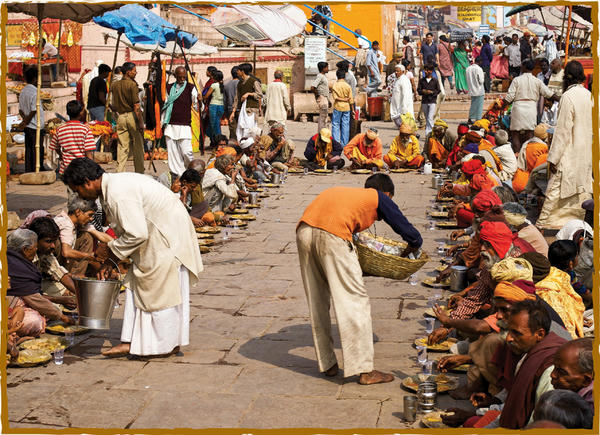
SHUTTERSTOCK
A BAPS volunteer serves meals to the impoverished
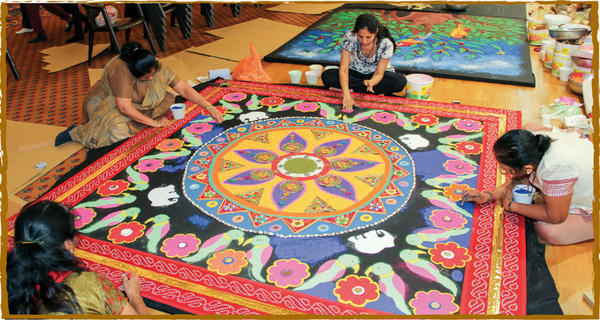
BAPS SWAMINARAYAN SANSTHA
Heartfelt efforts: At BAPS London, devotees create colored-flour rangolis in preparation for Diwali
Driven by Inspiration
THERE ARE MANY OPPORTUNITIES TO PERFORM SEVA BY HELPING out at temples with daily chores and puja preparations. We can also take time to hold classes for children, sharing the basics of our religion and culture. Visiting the elderly is a form of service that is greatly appreciated.
How much service should we perform? My guru suggested ten percent of one’s time, or four hours a week. “Everyone, no matter what their skills, can and should give ten percent of their time each week in service to their religious institution. We calculate it as four hours a week, which is ten percent of a forty-hour work week, which amounts to 208 hours a year. It is also acceptable to tithe, give ten percent of, one’s time in intense projects all at once, rather than each week. For example, many of the devotees who helped build the Swaminarayan temple in London took months and even years off from their professions and labored twelve hours a day to build that magnificent edifice.” All such acts of seva earn punyam, good karma, merit that we carry into our next birth. In fact, merit is the only true wealth, for it is the one possession we can take from one life to the next.
When asked if there are advantages of doing seva at a temple or ashram, Gurudeva affirmed, “It is much better to do Sivathondu in a sacred place, such as a temple or an ashram. Here acts of selfless service are part of the proper way of behavior. While performing your work, you are observed by the devas living on the inner, astral planes. You are noticed by the priests and the management of the temple. The guru of the ashram would observe you. The hearts of these beings go out to you to help your efforts acquire punyam. Thus, a spiritual fellowship is established. Many minds are aware of you, blessing your efforts. The effect is that you are drawing closer and closer to Lord Siva. More security comes as a result.”
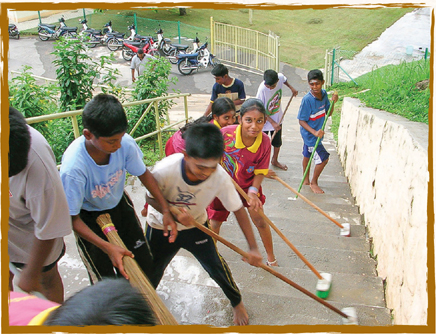
SYBO
SYBO volunteers in Penang, Malaysia, clean the temple steps
Examples of Seva Programs
Disaster relief is large-scale form of dynamic seva. For example, in 2004, when a giant tsunami lashed coastal areas across South and East Asia, causing death and destruction on a massive scale, Seva International sprang into action to build houses, community centers, vocational training centers, schools and orphanages.
Hindu seva is developing in the Diaspora in varied ways. Once a community is established in a new land, it has a choice: to engage with the population by helping, or to remain apart and sequestered. Groups who reach out and get involved in service projects earn respect, acceptance and good will. BAPS, known for their fabulous temples, places strong emphasis on bonding with the broader community. Here are just some of the creative offerings of the Neasden Temple in London: a special drive to enroll members of the South Asian community onto the National Bone Marrow Donor Register; a Community Health Fair; Neighbors Appreciation Day; a Party for the Elderly from local care homes; and an Annual Charity Challenge Supporting British Heart Foundation and Rosa (a charity that supports women and girls in the UK).

HABITAT FOR HUMANITY
Members of the West Michigan Hindu Temple join with Habitat for Humanity to build homes for needy families
Many Hindu organizations in India are entirely seva-centric. A remarkable example is the Narayani Peedam in Vellore, Tamil Nadu, offering prodigious philanthropic events, health care, free meals for visitors, support for other temples, mass marriages, prisoner reintegration, shelter for cows, afforestation, recycling, educational programs and more.
Encouraging Youth to Get Involved
AYOUNG MAN STUDYING MY GURU’S TEACHINGS RAN ACROSS the statement “We must perform our duty to our community” and asked me what it meant. I answered that the community in which we live is like a distant part of our family, and as such we have a duty to help and support them. We need to devote part of our time and financial resources to helping solve community problems, such as providing food and clothing to the poor and organizing volunteers for after-school programs.
At the Auroville community outside Pondicherry, South India, we spoke to teachers about how they awaken spirituality in their students. One instructor shared a favorite tactic, to have each student secretly help another student in some way every day. She was delighted to find how much the children enjoy and are uplifted by the practice.
A recent news story featured a group of college students who traveled to New Orleans during school break to help with disaster relief in the wake of Hurricane Katrina. For two weeks they lived in simple conditions and helped repair damaged homes. Their testimony was heartfelt: they had never done anything like this before, were astonished at how good it made them feel, and hoped to have an opportunity to volunteer again and do more such rebuilding work in the future.
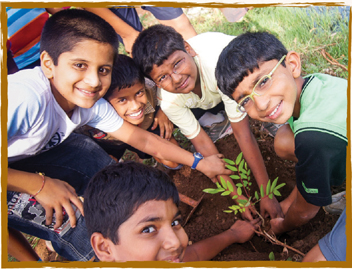
CHINMAYA INTERNATIONAL RESIDENTIAL SCHOOL
Pitching in: Children of the Chinmaya International Residence school in Coimbatore join forces to plant trees
These stories illustrate the benefit of having youth participate in volunteer programs with their parents or other youth and be taught that Hindu dharma includes helping others and serving the broader community.
Mathan Kalimuthu, age 22, a volunteer at the Waterfall Temple in Penang, Malaysia, shares: “Our seva will give us a lot of benefit in times to come, if not immediately. We will carry forward this good karma to our next birth. I appeal to parents to allow their children to join temples and do the service work. They need to understand what service and spirituality can bring to their lives. Through the SBYO (Shri Balathandayuthabani Youth Organization) I have developed a spiritual way of looking at life. I learned to walk on the right path and do good things.” Young Nannthini Shunmugam shared, “We organize seminars twice a year after the exams to help youth plan for their higher education. It gives me a lot of satisfaction and peace of mind to serve the Lord through SBYO.”
Parents are naturally focused on making sure their children are as successful in life as possible, which equates with studying hard and getting good grades. Unfortunately, they may feel that helping out occasionally in volunteer work or doing seva at the temple would be a waste of precious time. The SYBO example shows the opposite. While looking after the temple’s various needs, youth learn to work as a team, interact with the public and function in an efficient, disciplined and organized manner. Working with SBYO has made them self-confident and enthusiastic and more successful in their academic and professional work outside the temple. Parents who gained these qualities through decades of service in the SBYO are now working to pass them on to their children.
To experience such life-lessons themselves, children should be encouraged to spend time regularly helping others in any of the numerous seva programs that are available.
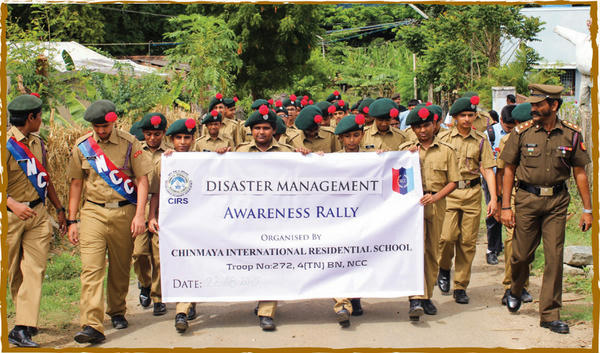
CHINMAYA INTERNATIONAL RESIDENTIAL SCHOOL
Youth volunteers of India’s National Cadet Corps hold an awareness rally for disaster management
Here are more testimonies from youth.
Shalini Pandya, Atlanta, Georgia: “Doing seva has built my interpersonal skills, has created a supportive community for my academic and spiritual strength, but most importantly, has helped me create my purpose and identity in my life endeavors.”
Roshni Dave. Houston, Texas: “Given the opportunity of doing Seva, I have benefitted both mentally and spiritually. Mentally I have gained more confidence and am able to balance my school, work, and Seva. Spiritually, I have been able to keep moving closer in attaining shanti, inner peace and bliss.”
Nakita Makan, Toronto, Canada: “The greatest reward in doing seva is the feeling of humility. Being able to understand that everything we have previously done, are currently doing or will do is due to the grace of God. So no matter how small, seva is seva as long as we walk away with this understanding, ego-free.”
Seva: A Remedy for Mental Turbulence
IN DISCUSSING THE CALMING AND PURIFYING ASPECTS OF KARMA yoga, texts often begin with a discussion of prakriti. Prakriti is primal nature, the original energy from which the intellect, emotions and physical body are formed. Prakriti, also called pradhana, is expressed as three gunas (qualities)—sattva, rajas and tamas.
Sattvaguna is rarified, translucent, pervasive, reflecting the light of pure consciousness. It is the most subtle of the three gunas. Rajaguna is the stimulative, restless, expansive energy of growth and movement. It is said to be the driving power animating the other two gunas. Tamaguna is the quality of denseness, inertia, contraction, resistance and dissolution. It is the densest of the gunas.
These three gunas manifest as light, activity and inertia, and in the mind as happiness, sorrow and delusion. They dominate the soul’s powers of knowledge, action and desire (jnana, kriya and icchha), and form the guna body, manomaya kosha.
The challenge many of us face is that our minds are under the influence of rajas and are therefore restless, agitated and distracted. If we sit and attempt to meditate, the mind automatically continues its restless pattern of constant distraction and does not allow us to experience anything of a contemplative nature. Through the harmonious actions of karma yoga, in which we are active in a selfless and detached manner, the restless activities of the mind, which are rooted in the ego, can be gradually subdued.
Swami Krishnananda of Divine Life Society offered: “The agitation, which is also a kind of activity, can be subdued only by another kind of activity, as a disease is cured by homeopathic medicines of a character similar to the disease already prevailing in the body. Similia similibus curantur: Like cures like. Action can be controlled only by action; diamond can be cut by diamond.... God-oriented work is the means of putting down work that causes agitation. Binding action can be subdued by liberating action. This is known as karma yoga.”
Another obstacle to contemplation is a troubled subconscious mind. The subconscious contains all the impressions of our past actions and our reactions to them. Karma, or action, that is hurtful, selfish or self-indulging leaves impurities or darkness and trauma in the subconscious. We feel this as a sense of burden that we did not possess as a child.

SHUTTERSTOCK
Lending a hand: Raised hands represent the spirit of giving of one’s time to help others
Imagine a pond of water with large gold nuggets at the bottom. If the surface of the pond has ripples due to wind, or if the water is clouded by mud, we cannot see the gold nuggets. The gold represent our soul nature; the ripples represent an overactive intellect; and the water’s cloudiness represents subconscious impurities. In order to experience our soul nature and its oneness with God, our intellect must be quiet and our mind must be pure.
My Gurudeva indicates how karma yoga purifies the subconscious: “Go out into the world this week and let your light shine through your kind thoughts, but let each thought manifest itself in a physical deed, of doing something for someone else. Lift their burdens just a little bit and, unknowingly perhaps, you may lift something that is burdening your mind. You erase and wipe clean the mirror of your own mind through helping another. We call this karma yoga, the deep practice of unwinding, through service, the selfish, self-centered, egotistical vasanas (subconscious inclinations) of the lower nature that have been generated for many, many lives and which bind the soul in darkness. Through service and kindness, you can unwind the subconscious mind and gain a clear understanding of all laws of life. Your soul will shine forth. You will be that peace. You will radiate that inner happiness and be truly secure, simply by practicing being kind in thought, word and deed.”
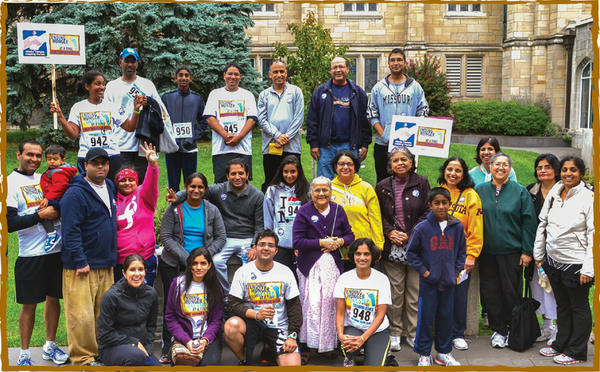
VELLORE S. GOPALARATNAM
The Helping Hands team at the Hindu Temple and Community Center of Mid-Missouri (HTCC) pose for a group photo in Columbia after the annual 5K Run/Walk for the Communities Responding to Overcome Poverty.
He spoke highly of the benefits of service, “The psychological secret is to have a goal, actually many goals, in service to humanity to accomplish. People helping people, people serving people; that is what the Hindu dharma is and has been proclaiming for some 8,000 years or more.”
Gurudeva summarized, “Once a lot of Sivathondu (service dedicated to God) has been performed and the lower nature has been quietly sealed off, the raja yoga practices of breath control and deep meditation can begin. The process of purification is similar to clearing a mountain path to walk upon. First the big stones are removed. Then the medium-size stones are removed. This process goes on until the path is clear of all stones. This is the refinement process we must go through on the charya and kriya margas before we enter the yoga marga. Sivathondu is the refiner.”

